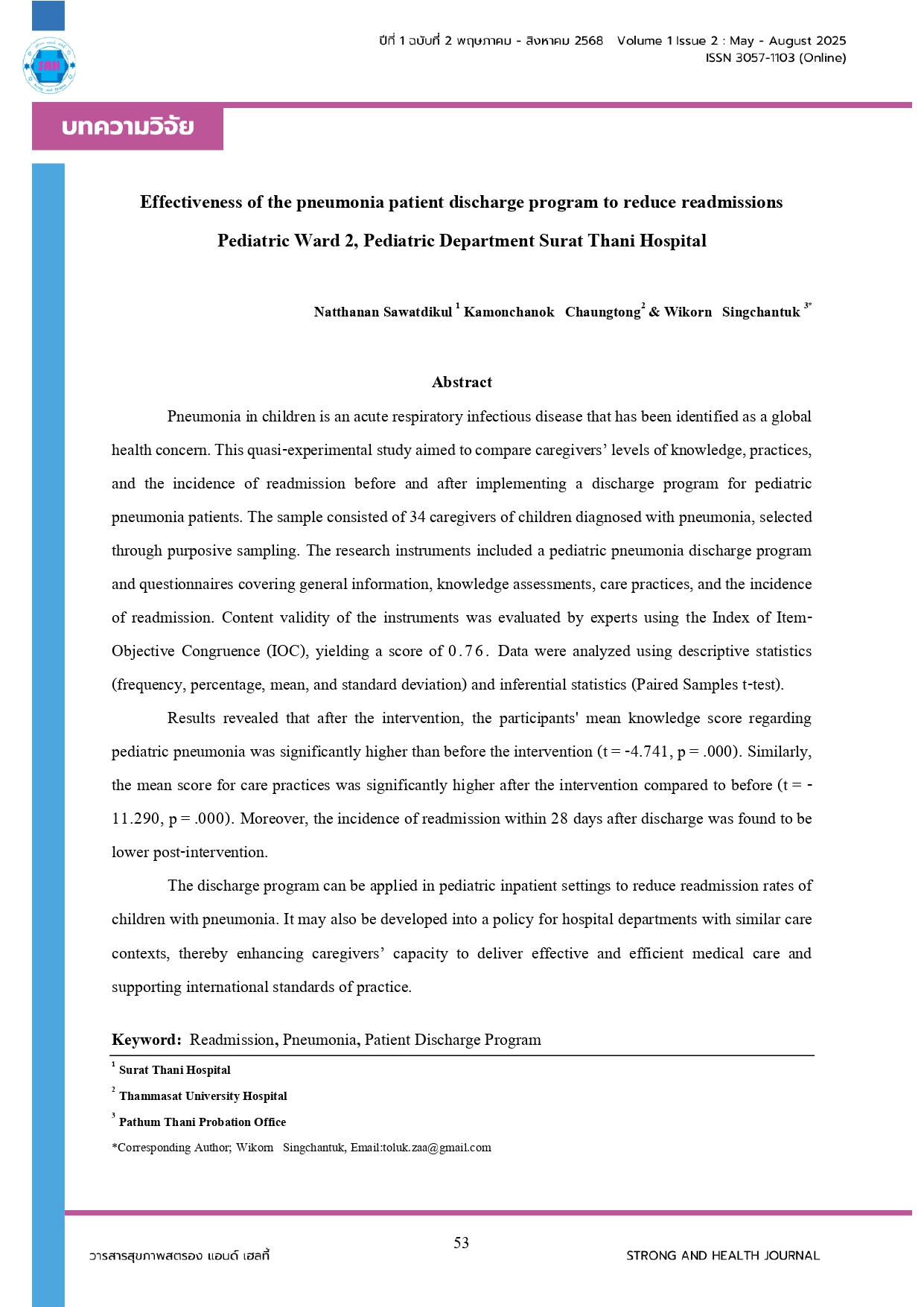Effectiveness of the pneumonia patient discharge program to reduce readmissions Pediatric Ward 2, Pediatric Department Surat Thani Hospital
Main Article Content
Abstract
Pneumonia in children is an acute respiratory infectious disease that has been identified as a global health concern. This quasi-experimental study aimed to compare caregivers’ levels of knowledge, practices, and the incidence of readmission before and after implementing a discharge program for pediatric pneumonia patients. The sample consisted of 34 caregivers of children diagnosed with pneumonia, selected through purposive sampling. The research instruments included a pediatric pneumonia discharge program and questionnaires covering general information, knowledge assessments, care practices, and the incidence of readmission. Content validity of the instruments was evaluated by experts using the Index of Item-Objective Congruence (IOC), yielding a score of 0.76. Data were analyzed using descriptive statistics (frequency, percentage, mean, and standard deviation) and inferential statistics (Paired Samples t-test).
Results revealed that after the intervention, the participants' mean knowledge score regarding pediatric pneumonia was significantly higher than before the intervention (t = -4.741, p = .000). Similarly, the mean score for care practices was significantly higher after the intervention compared to before (t = -11.290, p = .000). Moreover, the incidence of readmission within 28 days after discharge was found to be lower post-intervention.
The discharge program can be applied in pediatric inpatient settings to reduce readmission rates of children with pneumonia. It may also be developed into a policy for hospital departments with similar care contexts, thereby enhancing caregivers’ capacity to deliver effective and efficient medical care and supporting international standards of practice.
Article Details

This work is licensed under a Creative Commons Attribution-NonCommercial-NoDerivatives 4.0 International License.
References
Mckeehan, E. M. (1981). Continuing care: A multidisciplinary approach to discharge.
กรมควบคุมโรค กระทรวงสาธารณสุข. (2565). แนวทางการรักษาปอดอักเสบในผู้ใหญ่. สำนักงานปลัดกระทรวงสาธารณสุข. เข้าถึงได้จาก: https://www.ddc.moph.go.th
กระทรวงสาธารณสุข. (2565). ข้อมูลเกี่ยวกับปอดติดเชื้อ. https://www.moh.go.th/pneumonia
คณะแพทยศาสตร์ศิริราชพยาบาล มหาวิทยาลัยมหิดล. (2565). การดูแลผู้ป่วยปอดอักเสบจากเชื้อในผู้ใหญ่: แนวทางการปฏิบัติและการพยาบาลที่ดีที่สุด. เข้าถึงได้จาก: https://www.si.mahidol.ac.th
ฐิตินันท์ ไมตรี. (2558). ผลของการวางแผนจำหน่ายผู้ป่วยเด็กโรคหืดต่อความรู้และทักษะของผู้ดูแล โรงพยาบาลธรรมศาสตร์เฉลิมพระเกียรติ.
นวลตา โพธิ์สว่าง, สุดใจ ศรีสงค์, และเพชราภรณ์สุพร. (2557). การพัฒนารูปแบบการวางแผนจําหน่ายผู้ป่วยโรคปอดอุดกั้นเรื้อรัง. วารสารการพยาบาลและการดูแลสขภาพ, 32(1), 165-175.
ภาวิณี ช่วยแท่น, ภรณี วัฒนสมบูรณ์, และสุปรียา ตันสกุล. (2563). ผลของโปรแกรมสุขศึกษาเพื่อส่งเสริม พฤติกรรมป้องกันการกลับมารักษาซ้ำในมารดาเด็กโรคปอดอักเสบ. วารสารสุขศึกษา, 43(1), 12-24.
โรงพยาบาลสุราษฎร์ธานี. (2566). จำนวนผู้ป่วยที่ได้รับการวินิจโรคโรคปอดติดเชื้อ โรงพยาบาลราษฎร์ธานีปี 2563 – 2567 [เอกสารที่ไม่ได้ตีพิมพ์]. งานศูนย์ข้อมูล โรงพยาบาลสุราษฎร์ธานี.
ศริญญา ไชยยา. (2560). สรุปรายงานการเฝ้าระวังโรคประจำปี 2560. เข้าถึงได้จาก


